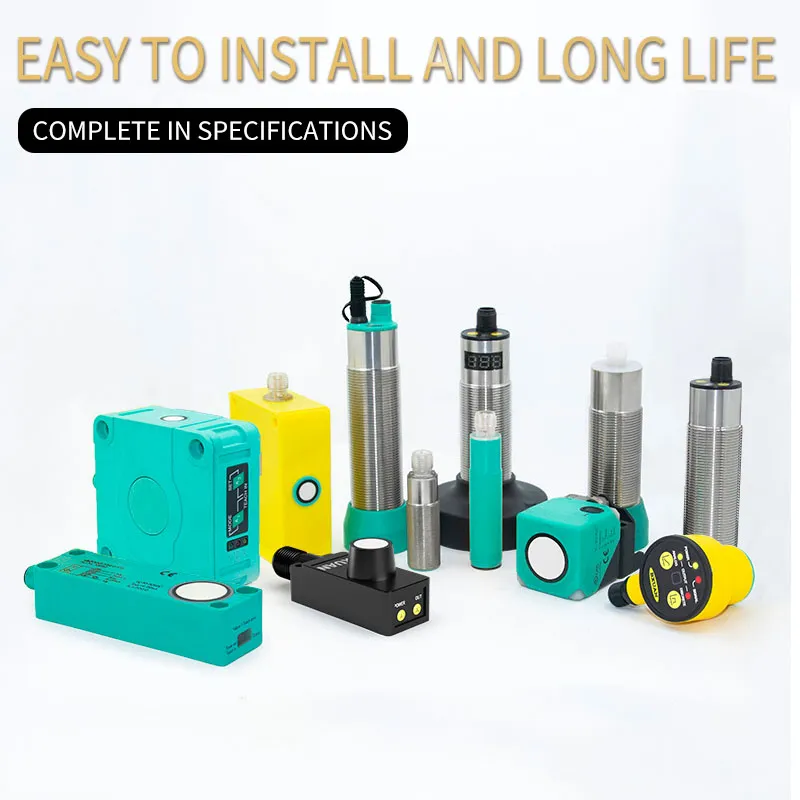Si Sensorët Ultrasonike Lejojnë Mjedosin Pa Kontakt
Principet Kryesore të Zbulimit Baze Për Sygje
Sensorë me ultrazotë pune në funksion duke përdorur valë të larg shqetësishme në zonën ultrasonike, zakonisht midis 23 kHz dhe 40 kHz, të cilat janë shumë larg aftësive tonore të njeriut. Këto valë shqetësore hulumtojnë objekte, kthynë prapa në sensor për të furnizuar të dhëna rëndësishme për matje dhe zbulim. Një komponent i çelëvît të teknologjisë së sensorëve ultrasonike është kristali piezoelektrik, i cili mbaj të dy rol: konvertimi i energjisë elektrike në valë shqetësore dhe anasjellta. Kjo transformim efikase lejon sensorit të arrin me sukses në mjedise komplekse dhe të gjashte informacion të sakta rreth objekteve larg dhe larg. Efikasiteti i zbulimit bazuar në shqetësi var pjesërisht nga frekuenca e valëve shqetësore të emituara dhe shpejtësia e tyre nëpër medinë, shpesh ajër, që arrin rreth 343 metra për sekondë në temperaturë të ndërtimit. Principit e tillë bazejo aftësinë dhe sigurinë e sensorëve ultrasonike në aplikime të ndryshme.
Metodologji e Llogaritjes së Kohës së Larg
Senjatorët e ultrasonore përdorin metodologjinë e kohës së largimit për të mat përgjegjshmërisht distancat. Kjo teknikë përfshin caktimin e kohës që i duhet një impulsi ultrasonor për të larguar deri në një objekt dhe të kthyer prapa. Largimi i kohës i përjetësues në këtë larg-larg-përpar është drejtpërdrejt proporzional me distancën midis senjatorit dhe objektit. Përmes llogaritjeve të sakta duke përdorur formulën Larg = (Shpejtësia e Zbritjes x Koha) / 2, senjatorët mund të arrin akuracijë të thellera në matjen e afërimit. Kjo ekuacion lejon senjatorit të caktoj gjatjen e largimit duke pjestuar kohën llogaritur me dy, duke llogaritur kthesën e shenjës. Kjo metodë tregon rëndësinë e largimit të kohës në ofrimin e ndjeshmive të plotë të distancave, të cilat janë të rëndësishme për aplikime industriale dhe konsumatore që kërkojnë zgjidhje për matje pa kontakt.
Në thelb, edhe principet kryesore dhe metodologjia e kohës së largimit tregojnë rolin e rëndësishëm të senjatorëve ultrasonore në peizat teknologjike moderne.
Konfigurimet e Transmetuesit vs. Transciver
Larg dhe Zonat e Paqarshme në Arrangetimet e Komponenteve
Kur bëhet fjalë për sensorë me ultrazotë , konfigurimi — jashtëzakonisht si transmetues ose si transciver — ka ndikim në zonat e paqarshme ku matjet e saktë janë të vështira. Konfigurimet e transmetuesit kanë zonat e paqarshme specifike për shkak të kërkesave të afërimit midis unitave të veçanta për transmetim dhe pranim. Ky arranjim lyp kujdes të rritur në vendosjen e sensorëve për të shmangur zonat ku signalët mund të zgjithen pa efikasni. Në anë tjetër, konfigurimet e transciverit, që përbjeshin transmetuesin dhe pranuesin në një unit, mund të largojnë zonat e paqarshme në mënyrë të rëndësishme. Kuptimi i këtyre ndryshimeve është thelbësor për optimizimin e vendosjes së sensorëve në aplikime të ndryshme, duke siguruar se gabimet e zbulimit nuk lindren efikasitetin operativ.
Optimizimi i Hapësirës PCB dhe Larg dhe Sensitiviteti i Signalit
Në dizajnin e sensorëve ultrasonike, përdorimi i transceiverëve mund të shkaktojë arranjet më të ngushta dhe efikase të Plaketës Shtypur Circuit (PCB). Transceiverët integrojnë funksionet e dërgimit dhe pranimit në një komponent të njëjtë, duke larguar numrin e pjesave të ndara që kërkojnë. Kjo bashkëngjitje e largon hapin në PCB dhe përmirëson ndjenjën e signalit, lejon do sensorit të zbulojë objekte me më tepër akuracijë edhe në mjedise vështire, si ato me larg dhe ulë dhe nivel të larg të larg. Duke optimizuar arrangerimin e komponenteve, dizajnerët mund të arrin performancë më të mirë pa kompromis të hapit ose fido, bënjë transceiverët një zgjedhje shumëfisni në aplikimet e teknologjisë ultrasonike.
Forca Kryesore të Teknologjisë Ultrasonike
Hapsetri i Larg dhe Larg Nga Ngjyrat
Senjorët ultrasonore kanë aftësinë unike të matin gjithmonë nëpër lloje të ndryshme materiale, duke u bërë pambargshmë në scenari që në të cilin hyrja vizuale nuk është e mundur. Zbatimi i tyre i bazuar në zonjë e lejon për ta punuar efikashtë, indajse nga ngjyrën ose llojin e materialit të objektit, çka e ndan ato nga senjorët optikë që varren nga rifletim i lumit dhe mund të hidhen nëpërmjet nga vetitë siperfaqe, siç janë ngjyra ose tekstura. Kjo transparncë materiale lejon senjorëve ultrasonore të funksionojnë në aplikime të ndryshme, indajse në rastin e zbulimit të objekteve paqësore ose të thellera, siç janë uji ose gjasht në kontekste industriale apo në vlerësimin e nivelit të lichnidhëve.
Larg dhe Larg nga Zbatimet EMI dhe Larg dhe Larg nga Larg dhe Larg Zgjerimi
Teknologjia ultrazanore është nga e vetja rezistente ndaj ndërhyrjeve elektromagnetike (EMI), duke siguruar performancë të besueshme në mjedise ku zhurma elektronike mund të jetë problematike. Kjo karakteristikë është veçanërisht e vlefshme në mjedise industriale të mbushura me EMI që zakonisht i shkatërrojnë teknologjitë e tjera të ndjeshme. Për më tepër, sensorët ultrazanorë dallohen për funksionimin e tyre të mirë në prani të zhurmës ambientale, nga magazinat e ngarkuara deri te fabrikat e nxehta. Aftësia e tyre për të ruajtur besueshmërinë operative në kushte të tilla e bënë ato të përshtatshme për një gamë të gjerë aplikimesh, si p.sh. zbulimin e afësisë së objekteve apo niveleve të lëngut në mjedise ku zhurma ambientale mund të pengojë matjet e sakta.

Kufijtë Kryesore në Aplikime Praktike
Përdorimi i Temperaturës/Humiditetit në Akuracijë
Temperaturat e larg dhe lumësia mund të ndikojnë pjesërisht në akuraten e sensorëve ultrasonore. Këto faktorë ambientale mund të zbullojnë valët e zemrës që jepen nga sensorët, duke shkakuar gabime në matjen e largit. Kur temperaturat rriten ose nivelet e lumësise rriten, shpejtësia e zemrës në ajër mund të ndryshojë, duke ndikuar kohën që i duhet valëve të zemrës për të ulet deri në objektin e tyre dhe prapa. Këto ndryshime kërkojnë mbajtje të kujdesishme të faktorëve ambientalë para se të depozitojmë sensorë ultrasonore, veçanërisht në kushte të keq. Ignorimi i këtyre kushteve mund të shkaktojë performancë të pandovura dhe të dhëna të gabuara, bënjë kështu të thelbësore të monitorizohet dhe të rregullohet për temperaturë dhe lumësi.
Provaret me Urfër të Larg dhe Ambientet në Zgjerim
Sensores ultrasonore përfaqesojnë sfidë të rëndësishme kur interagin me sipërfaqe mekete dhe në mjedise në vacum. Materialet meke, si foamja ose stofa, ndjekasni tendencën e absorbiçimit të valave zanore në vend që të ta rifletojnë. Kjo absorbcion mund të rezultojë në lexime mëpafërse sepse valat mund të mos kthehen efikace në sensor. Ndersa, në një vacum, ku nuk ka medhaku për larg dhe vijim të valave zanore, sensores ultrasonore bëhen plotësisht joefektive sepse zvogli nuk mund të propagojë. Këto barajra tregojnë kufijtë e sensorëve ultrasonore dhe shenjon nevojën për vlerësimin e mjedisit të aplikimit kur zgjidhet për sensore për detyra specifike. Mbrojtja e këtyre kufijeve lejon vendimet më informuara, duke siguruar se teknologjia e duhur zgjaseta për çdo situacion unik.
Aplikime Industriale të Sensorëve Ultrasonorë
Monitorimi i Nivellit të Largut në Kontroll Procesi
Senjorët ultrasonore janë pjesë e rëndësishme në kontekste industriale për monitoresin e nivellit të lizhit në rezervoarë, luajnë një rol kryesor në optimizimin e menaxhimit të inventarit dhe kontrollit të procesit. Këto senjorë përdorin teknologji të përparuara për të ofruar matje të sakta, pa kontakt, reduzues vetëm rrezikun e kontaminimit që lidhet me metodat e matjes me kontakt drejtë. Për industritë që kërkojnë norme higjienike të ngushtë, siç janë farmaceutikët ose ushqimi dhe piqeri, ky veprim është veçanërisht i dobishëm. Duke përdorur senjorë ultrasonore, industritë mund të sigurojnë akuracinë e monitores se nivellit të lizhit, çka ndihmon në mbajtjen e efikasitetit të operacioneve të tyre. Së shumë, fleksibiliteti i senjorëve ultrasonore në trajtimin e llojeve të ndryshme të lizhit, indiferent nga transparenca ose ngjyrën e tyre, bën të tregojnë përdorimin e tyre në sektorë të ndryshme.
Sistemet për Largim të Nderimesh në Automobilistik
Në industrinë automobilistike, senzorët ultrasonore kanë bërthyer komponente rëndesishme të sistemeve të ndihmës së avancuar për shofer (ADAS), dukeu luajtur rol të vërtetë në eparimi të ngadgjithjes. Duke zbuluar akordhese rreth automjeteve, këto senzorë përmirësojnë sigurinë përmes veçorive si ndihma në parkim dhe zbulimi i zonave paqyte. ADAS që përfshijnë këto teknologji ultrasonore ofrojnë shoferëve informacion real-time rreth mjedisit, zvogëllojne rrezikat të bashkuara me gabime njerëzore. Nga momenti që tendencat në industrinë automobilistike vazhdon të largohen drejtimin e automatisimit dhe veçorave të përmirësuara të sigurisë, kërkesa për senzorë ultrasonore të besueshme është e pritur të rritet, dukeu theksuar kontributin e tyre të rëndësishëm për teknologjinë moderne të automjeteve.
Tendencat e Reja në Dallimin Ultrasonor
Integrimi me IoT dhe Prodhimin e Larg
Integrimi i sensorëve ultrasonike me Internetin e Gjithshtuajseve (IoT) po rregulloj lëndat e prodhimit të aftë nënfaqe ndihmën për shkak të transmetimit të të dhënave në kohë reale. Kjo bashkëngjitje e fton operacione më efikase dhe e fortizon strategitë për mbajtjen prediktiv. Duke e kolektuar dhe analizuar të dhënat nga ndërtesa të ndryshme të sensorëve, prodhuesit mund të parashikojnë dështime të ekipimenteve dhe të programojnë mbajtjen proaktive, duke larguar kohën e pastruara dhe duke përmirësuar produktivitetin. Një shembull i kësaj mund të shohet në linjat e montimit ku sensorët ultrasonike monitorojnë montimin e pjesave, duke dërguar alarme nëse zbulohen neshmije. Kjo tendencë e shenjon rolin e rëndësishëm të teknologjisë ultrasonike në qarkullim efikas dhe inovativ në kontekst industriar.
Kompensim Adaptiv për Variablat Largjeksione
Larg dhe përmirësimet në teknologjinë e kompensimit adaptiv janë duke rritur varfshmërinë e sensorëve ultrasonore duke lejuar për tyre të rregulliten cilindrat e tyre bazuar në faktorë ambientale. Këto aftësi janë veçanërisht e rëndësishme në sektorë si robotikë dhe automatizim, ku matja e precize është e thelbëshme për performancën e sistemit. Sistemet adaptiv me këtë ndihmë largohen nga gabimet që shkaktojnë variablat si temperatura dhe largdhe, duke siguruar se sensorët mbajnë akuratësinë e tyre indakuar nga ndryshime të kushteve. Kjo teknologji është veçanërisht e dobishme në ambientë me kushte të ndryshme, sepse e lejon sensorëve të jepin performancë të njëjtë pa ricilibrim manual. Kjo tendencë shenjon rëndësinë e inovacionit në zhvillimin dhe aplikimin më tej të sensorëve ultrasonore në kontekste industriale të kërkuara.
Pyetje të Bëra Shpesh
Për çfarë përdoren zakonisht sensorët ultrasonor? Senjorët ultrasonore përdoren për aplikime matje dhe zbulimi pa kontakt, siç janë monitorimi i nivellit të liqideve në industrinë industriale dhe sistemet e shmangjes së çudit në industria automobilistike.
Pse teknologjia ultrasonore është rezistente në konfront me EMI? Teknologjia ultrasonore përbazohet në valë shenjake dhe jo në valë elektromagnetike, kështu që ajo është imune në konfront me ndikimin elektromagnetik të cilat mund të rrafshojnë teknologji të tjera elektronike për zbulim.
A mund të funksionojnë senjorët ultrasonore në mjedise me ndallime temperaturash? Po, me progresin në teknologjinë e kompensimit adaptiv, senjorët ultrasonore mund të rregullojnë cilindra për të mbajtur akuracitet edhe në kushte ambientale të ndryshme.
Cilët janë kufijtë e senjorëve ultrasonore? Senjorët ultrasonore mund të takojnë nga temperatura larg, ajershmiritë dhe luftojnë me sipërfaqe blake që absorbojnë valë shenjake, si dhe në mjedise vakuum ku shenja nuk mund të zgjithë.

